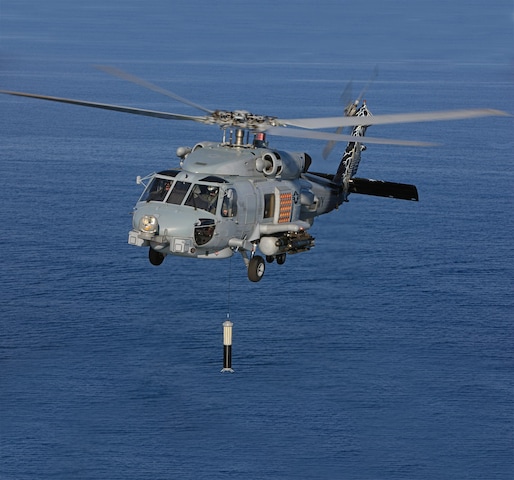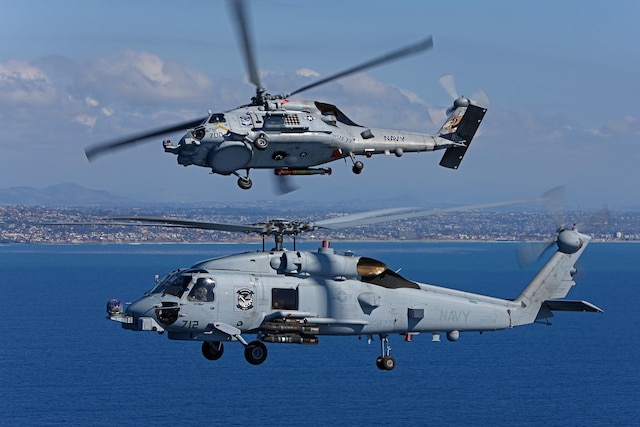Indian Navy’s first MH-60R sub-fighter squadron takes to the skies: everything you need to know | India News – Business Standard
Newly introduced MH-60R Seahawk multi-role helicopter of Indian Navy. Image credit: SpokespersonNavy
The Indian Navy inaugurated the first squadron of the newly introduced MH-60R Seahawk multi-role helicopter at INS Garuda, Kochi on March 6. The Seahawk is a maritime variant of the better known Blackhawk helicopter. According to the Navy, its commissioning marks “a pivotal moment in the modernization of India’s defence”. The Seahawk squadron has been commissioned into the Indian Navy as Indian Naval Air Squadron (INAS) 334. The Navy made the announcement on social media platform X, accompanied by a video introducing the squadron and the machines it will operate.
— SpokespersonNavy (@indiannavy) March 6, 2024
These platforms are part of a $2.6 billion Foreign Military Sales agreement for 24 Lockheed Martin/Sikorsky MH-60R Seahawk helicopters for anti-submarine warfare and anti-surface warfare. The acquisition deal was announced by India and the United States in February 2020, and delivery of the entire fleet is expected to be completed by 2025. These helicopters are manufactured by Sikorsky, a subsidiary of aerospace giant Lockheed Martin.
What does the MH-60R do?
Lockheed Martin describes the MH-60R Seahawk helicopter, or the “Romeo,” as an anti-submarine and anti-surface warfare platform. For the uninitiated, this means it can take out both enemy submarines and surface ships. It can operate from both shore-based facilities and ships. The MH-60R’s advanced digital sensors include a multi-mode radar, an electronic support system, an electro-optical or infrared camera, data links, aircraft survival systems, dipping sonar and sonobuoys. Lockheed Martin claims that Romeo’s fully integrated mission system processes the data collected by the sensors to build a complete situational picture of both the surface and subsea domains of the ocean. And with the useful knowledge this provides, the MH-60R can track, target and destroy ships or submarines. The Seahawks are also designed for search and rescue missions, medical evacuation, command and control missions, and vertical resupply missions. The MH-60R’s weapons include torpedoes, air-to-surface missiles, rockets and crew-operated guns. The Hellfire air-to-surface missiles and the Mark 54 anti-submarine torpedoes are some of the specific weapons these helicopters are equipped with.
— IN (@IndiannavyMedia) March 5, 2024
What is so special about the Indian Navy’s MH-60Rs?
The MH-60Rs intended for the Indian Navy have specialized equipment to meet Indian requirements and have reportedly been modified, including Identification Friend-or-Foe (IFF) transponder units from Hindustan Aeronautics Limited (HAL). Lockheed Martin is also working with Bharat Electronics Limited (BEL) for the integration of such equipment. Moreover, according to Janes, a defense news weekly and portal, the Indian Navy’s Seahawks are also equipped with a mission sensor suite, including the APS-153 multimode radar. The periscope detection modes of this radar assist the helicopter in hunting submarines.

A US Navy Sikorsky MH-60R Seahawk. Image credit: Lockheed Martin
Why does the Indian Navy need the MH-60R?
Consider the timing of their deployment, which coincides with the deepening of the Red Sea crisis in the wake of the Israeli-Palestinian conflict. As such, these Seahawks strengthen India’s ability to ensure maritime security and maintain regional stability. The deal for the Seahawks was signed after a decade of insistence by the Indian Navy, which was hampered by the dwindling and aging British-built Sea King fleet. The entry into service of the MH-60R also comes at a crucial time, given China’s increasingly aggressive attacks in the Indian Ocean.

A pair of US Navy Sikorsky MH-60R Seahawks sail across the Pacific Ocean. Image credit: Lockheed Martin
Who else pilots the MH-60R?
According to Lockheed Martin, the global fleet of MH-60R helicopters had achieved 1 million flight hours by early 2023. The helicopter is operational with the US Navy, Royal Danish Navy, Royal Australian Navy and Royal Saudi Naval Forces, with more than 330 delivered to date.
First print: March 7, 2024 | 12:41 pm IST
